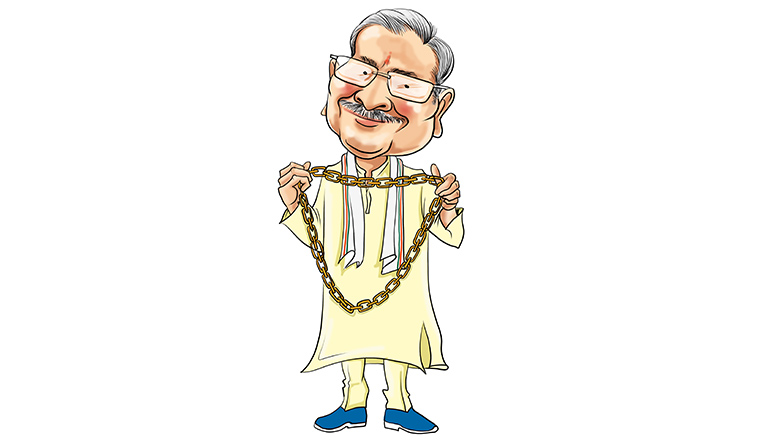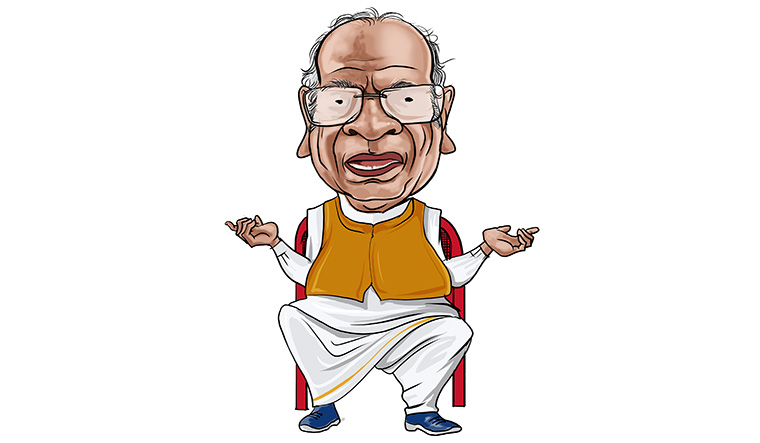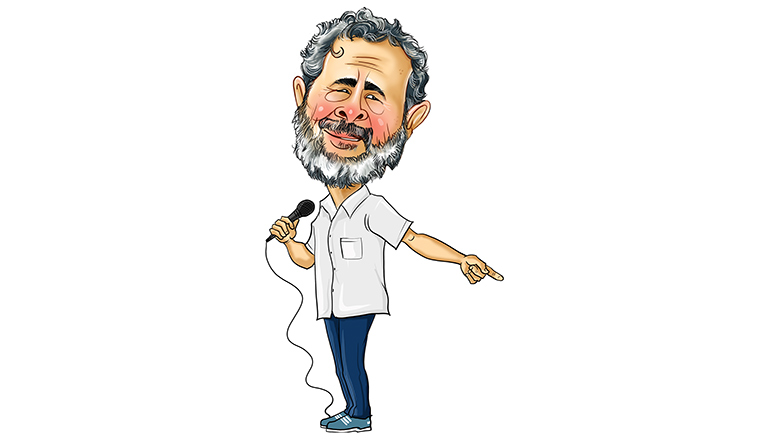Late in the afternoon on February 24, the first day of the 85th plenary session of the All India Congress Committee, as former party chiefs Sonia Gandhi and Rahul Gandhi arrived at the venue of the meeting in Nava Raipur, party president Mallikarjun Kharge obliged the waiting camerapersons by making Rahul pause on the steps of the building, putting his arms around his shoulders and manoeuvring him to face the flashlights.
That moment captured the excellent rapport between Kharge and Rahul. It also offered a glimpse into the respective roles that the two leaders are likely to play―while Kharge would deal with organisational responsibilities, Rahul would remain the face of the Congress. And it was also clear that Rahul, fresh from the successful completion of the Bharat Jodo Yatra, was the centre of attention at the session.
The session was important in terms of establishing Kharge’s leadership before thousands of AICC delegates―the party’s representatives at the grassroots level. But it was clear from the very beginning that while Kharge would helm the organisation, Rahul, freed from organisational responsibilities, would lead the party’s outreach as its face and its chief communicator. If the session’s primary purpose was to ratify Kharge’s election and allow him to put in place his own team and provide him an apt occasion to spell out his vision for the party, the highlight of the event was the yatra and the difference it had made to the morale of the ordinary party worker as much as it had enhanced Rahul’s image.
Earlier on February 24, Rahul was conspicuous by his absence at a meeting of the steering committee of the Congress, a panel that fills in for the Working Committee till it is reconstituted by the new president. Sonia and Congress general secretary Priyanka Gandhi Vadra, too, kept away. It was seen as an effort, besides other reasons, to convey that Kharge was in charge. It is another matter that it was also seen as an effort by the Gandhis, especially Rahul, to keep a strategic distance from a meeting which, on expected lines, decided against having elections to the CWC. Rahul is known to be a strong advocate of elections at all levels in the party. Also, the committee amended the party’s constitution to make former party presidents permanent members of the CWC, ensuring the inclusion of Sonia and Rahul. Thus, it was evident that while the Congress has got a non-Gandhi president after a long gap, the Gandhis continue to be its pivot.
Apart from throwing light on how the Kharge-Rahul arrangement was expected to work, the session was also important in terms of the need for the Congress to set in motion the long-pending organisational reforms and put in place a plan of action for the extremely crucial election season, which includes a series of assembly elections this year, culminating in the Lok Sabha polls in 2024. The expectation in the party was that the session would provide a new deal that would inspire and enthuse party workers. But a general feeling by the end of the three-day exercise was that the party had chosen to stay within the limits of its known ways of doing things.
A senior Congress leader said there was a relative sense of calm in the party in contrast with the internal turmoil caused by the explosive letter written by the group of 23 leaders to then party chief Sonia Gandhi. He said the passion with which the need to have a full time president was demanded and the spirit with which the election of a non-Gandhi president was welcomed were missing when the time came to discuss elections to the CWC. The overwhelming majority of the party’s top leaders who finalised the agenda for the session was in favour of allowing Kharge to decide who would be in the new CWC rather than allow elections. Even senior leader Anand Sharma, a member of the now disbanded G23, said he was for consensus. The argument presented in favour of not having elections to the CWC was that in a crucial election year, it would be unwise to rake up divisions in the party.
“I am disappointed. Elections to the CWC would definitely have been good for the party. It would have provided the AICC delegates with a sense of partnership and ownership in the process,”said senior Congress leader Sandeep Dikshit. With a number of decisions taken at the Udaipur chintan shivir pending, the session did approve amendments to the party constitution, which included expanding the CWC, increasing the number of AICC delegates, and, most importantly, keeping aside 50 per cent of posts at all levels in the party for Scheduled Castes, Scheduled Tribes, minorities, youth and women.
According to Congress general secretary Randeep Singh Surjewala, who was the convenor of the committee that finalised amendments to the party constitution, the quota was expected to bring in better representation of all sections in the decision-making process of the party. “The basic idea driving this change is that the party should start at its own home the changes that it has been advocating,”he said.
However, an AICC delegate from Agra expressed doubts about the implementation of the reservation formula at the grassroots level. “For example, it will be difficult to find enough women to fill the posts in smaller centres. Women will come and join only if there is any expectation of the party doing well. Especially in Uttar Pradesh, where we are in such a sorry state, women will not be allowed by their families to join the Congress,”he said.
A party leader from Delhi questioned the logic behind the ‘50 under 50’ quota, saying the criteria should not be age-based, but should rather look at the capabilities of the person. “I am 58 and that should not be held against me. I have come across many youngsters who have no new ideas to offer or lack the intellectual depth to bring about any change in the party’s political strategy,”he said.
A key issue that was expected to come up for discussion at the session was the question of getting anti-BJP parties to come together ahead of the Lok Sabha elections, and the role of the Congress in it. Both Kharge and Sonia spoke about the need to have an alliance similar to the United Progressive Alliance.
The Raipur Call to Action adopted at the end of the session said the Congress was “prepared to work with like-minded political parties on the basis of a common, constructive programme to preserve and protect the Constitution and to address the three main challenges facing the country: growing economic inequality, intensifying social polarisation and deepening political dictatorship.”
However, a senior leader said the question of opposition unity would become more clear only after the crucial assembly elections this year. The outcome of the state elections, he said, would determine the heft with which the Congress would be able to deal with other parties. “On the question of alliances, if we go state by state, wherever it is possible for us to be in an alliance or a seat sharing arrangement, we already have that. As for projecting a common united front at the national level, the party has signalled that it is willing to make sacrifices. A lot would depend on how we fare in the state elections,”he said.
It was, meanwhile, felt that the session failed to provide a clear answer to the question about the party’s ideology. Lack of clarity on the party’s response to the hindutva-driven politics persists despite Rahul’s strident opposition to the majoritarian narrative of the BJP and the RSS. There are no easy answers on the issue of ideology since opposing the BJP’s right-wing policies, it is felt, only helps polarise the polity further.
A majority of the AICC delegates were enthused by the response to the Bharat Jodo Yatra. The party is indeed pinning its hopes on the momentum generated by the yatra, and it was evident as the one time that the gathering really came alive was when Rahul, in his address, chose to tell the delegates about his experiences during the yatra.
“The yatra has come as a sanjeevani (elixir) for the party. It has given us the confidence about going out into the field and connecting with people. We need to build on this and have more mass contact programmes in the coming months,”said Ranjeet Kumar Mishra, in-charge of training in Bihar Congress.
“India awaits a reinvigorated Congress and we owe it to the people to fulfil their expectations. Crores of Congress workers must build on the momentum of the Bharat Jodo Yatra to defeat the divisive forces of the BJP and RSS. A mass awareness campaign will be launched against the crudest example of crony capitalism which the entire country and the world is seeing,”said the Raipur Call to Action.
In a crucial election year, the Congress, in its mega meet, chose to play it safe while hoping to build on the buzz created by the Bharat Jodo Yatra. No wonder, an east-to-west yatra is now being actively considered.
GRASS, NOT GOLD
 Illustrations: Job P.K.
Illustrations: Job P.K.
There was a distinct Chhattisgarhi touch in the welcome that Bhupesh Baghel accorded to senior leaders who arrived in Naya Raipur for the plenary session. The Chhattisgarh chief minister welcomed the leaders with garlands that looked like large golden chains. Many of the attendees were even seen asking Baghel what the garland was made of. The fake news factory took to social media saying that he had gifted the leaders gold chains. But the garland called ‘biran’ is made with grass and parts of a tree locally called ‘Khirsali’. Artisans from the Baiga tribe made the garlands for the delegates.
MORE THAN CASTE

Congress president Mallikarjun Kharge is not known for wearing his dalit identity on his sleeve. When Adhir Ranjan Chowdhury, leader of the Congress in the Lok Sabha, spoke at the meeting of the steering committee about the party having elected a dalit president, Kharge was quick to correct him. He said his appointment as Congress president had nothing to do with him being a dalit.
EMOTIONAL SOJOURN

Rahul Gandhi’s speech at the plenary session was, as expected, on his experiences during the Bharat Jodo yatra. But he infused his speech with loads of emotion as he referred to a childhood conversation he once had with his mother. As he narrated the incident, he realised that she was looking away from him. He paused and told the audience, “Look, she is not even looking at me right now”. It was, perhaps, too much of an overwhelming moment for Sonia, and she did not turn to look at Rahul, and he continued with his speech.


